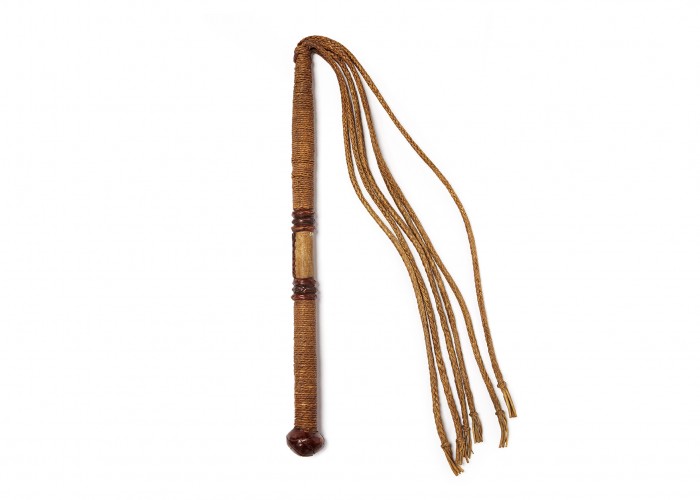Military Whip
The British Army that fought at Waterloo used savage punishments on its own soldiers. Officers often believed that only fear of brutal discipline could keep their men obedient. This item was used to inflict whippings on any non-commissioned officer or enlisted man for various offences.
In the latter case, the number of lashes was ordered by regimental or general court-marshal. The maximum sentence that could be meted out in the Army was 1,200 lashes, often resulting in a fatal outcome. The historian Sir Charles Oman reckoned that this sentence was delivered ‘9 or 10 times’ during the Peninsular War (1808-14). Sentences of 100-300 lashes were not uncommon. Regimental commanders and units varied in their use of this punishment.
It was a barbaric punishment, inflicting pain and humiliation on the victim. The whip was made from tough thin cord, with a variable number of knots tied on each strand of the whip (otherwise known as a ‘cat ‘o nine tails’). The handle was made of plaited cord, leather or wood. In the Royal Navy, the victim had to make his own whip, prior to punishment.
In the army, a tripod was constructed of three halberds or spontoons (both types of short pike) tied together. The man was stripped naked to the waist and punishment was carried out in front of the battalion or ship’s company. The lashing was usually carried out by regimental drummers, with an officer officiating. He could admonish the drummer for ‘laying on’ the whip too lightly or too heavily. He could also halt the punishment if the victim was having an extreme adverse reaction, or if the man was dead. Theoretically, if the man succumbed, the lashing had to be completed on the corpse of a dead culprit. More often the punishment was stopped if the battalion commander felt the man had suffered enough. Likewise the regimental surgeon, always present at punishment, could halt punishment for medical reasons. If halted, the punishment could be completed on a subsequent occasion.
Wounds were dressed with wet salt compresses and roller bandages. The punished soldier was expected to return to normal duties unless he had been seriously damaged. Flogging was made illegal by an act of Parliament in 1881.
-
Curatorial info
- Originating Museum: National Army Museum
- Accession Number: NAM. 1966-03-17
- Production Date: c.1850
- Material: Leather, whipcord
-
Use this image
You can download and use the high resolution image under a Creative Commons licence, for all non-commercial purposes, provided you attribute the copyright holder.
- Rights Holder: National Army Museum. Photography Relic Imaging Ltd.
- License Type: Creative Commons
Find it here
This object is in the collection of National Army Museum










